| کد مقاله | کد نشریه | سال انتشار | مقاله انگلیسی | نسخه تمام متن |
|---|---|---|---|---|
| 5536902 | 1402310 | 2017 | 8 صفحه PDF | دانلود رایگان |
عنوان انگلیسی مقاله ISI
Serological and molecular epidemiological outcomes after two decades of universal infant hepatitis B virus (HBV) vaccination in Nunavut, Canada
دانلود مقاله + سفارش ترجمه
دانلود مقاله ISI انگلیسی
رایگان برای ایرانیان
کلمات کلیدی
موضوعات مرتبط
علوم زیستی و بیوفناوری
ایمنی شناسی و میکروب شناسی
ایمونولوژی
پیش نمایش صفحه اول مقاله

چکیده انگلیسی
Chronic hepatitis B virus (HBV) infection within the Canadian Arctic is considered endemic (>2% prevalence). Within the Arctic region of Nunavut, a vaccination program targeted at newborn infants was initiated approximately 20 years ago, along with interim grade school catch-up programs, with the result that individuals born after 1980 are presumed vaccinated. This study investigates the effectiveness of these programs and is the first seroepidemiological survey to determine HBV prevalence in Nunavut in the post-vaccination era. Anonymized serum specimens scheduled for destruction following medical testing were collected between April 2013 and April 2014 from individuals granting consent. Specimens were tested for HBV antibodies, surface antigen (HBsAg), and HBV DNA to perform molecular characterization. Four thousand eight hundred and two specimens (13% of the population) were collected, with a resulting median age of 29 years (range 1 week to 93 years). The prevalence of antibody to the HBV core protein was 9.4%; however, a 10-fold decrease in the rate of HBV exposure was noted among those born after 1980 compared to those born before (1.8% vs. 19.8%, p < 0.01). HBsAg positivity was primarily documented in individuals born before 1980 (2.5%), although cases still occurred among the vaccine age cohort (0.3%). HBV subgenotype B5 (previously B6) was the most prevalent genotype observed (81.8%) indicating persistence of locally acquired infection. Vaccine-based antibody as the sole serological marker was evident in the vaccine age cohort, although the rate of decay with increasing age was much greater than predicted (less than 10% in those aged 5-19 years). Nearly two decades after the advent of HBV vaccination in Nunavut, HBV prevalence has decreased to 1.2%, indicating non-endemic prevalence. However, the persistence of infection and a lower than expected prevalence of vaccine-based immunity in the vaccine age cohort will require further investigation to understand the causes and consequences.
ناشر
Database: Elsevier - ScienceDirect (ساینس دایرکت)
Journal: Vaccine - Volume 35, Issue 35, Part B, 16 August 2017, Pages 4515-4522
Journal: Vaccine - Volume 35, Issue 35, Part B, 16 August 2017, Pages 4515-4522
نویسندگان
Chris Huynh, Gerald Y. Minuk, Julia Uhanova, Maureen Baikie, Thomas Wong, Carla Osiowy,